Your product data feed is the main weapon in your digital marketing armoury. A state-of-the-art product data management platform will help you get the most out of it.
If you run an e-commerce business, optimising product data feeds is probably your biggest opportunity and your greatest challenge. Product feeds are the showcase for your products on potentially hundreds of different channels, not only on shopping and search networks like Google Shopping but increasingly on social media sites like Facebook, product marketplaces like Amazon and eBay and in dynamic retargeting adverts that run across the whole Internet.
As your e-commerce business grows, and your digital marketing strategy develops, your product feed plays an increasingly important role in each of these dynamic and constantly changing channels.
So if you are considering how best to manage your product data feed you almost certainly need an understanding of the different requirements of the different channels and the benefits that a specialist product feed management partner can bring in each of these established and emerging markets.
- Build Your Product Data Strategy on a Firm Foundation with a Product Feed Platform
- Not All Product Feeds are like Google Shopping Feeds
- Why Facebook Product Ads are Different from Google Shopping
- Welcome to the Jungle (of Product Marketplaces)
- Dynamic Advertising also Provides a Strong Return on Ad Spend (ROAS)
- Other Product Data Channels are Available
- Actionable Insights, Insightful Actions - How Your Product Feed Management Software Can Help
- Integrate Your Advertising Platforms and Your Feed Management System
- The Essential Shopping List when Searching for the Best Product Feed Management Software
- Future-Proofing your Product Feed Management Partner Checklist
- Intelligent Reach: Beyond Product Feed Optimisation
Build Your Product Data Strategy On A Firm Foundation With A Product Feed Platform
Your product data feed is a file that contains information about your portfolio of products. Think of it as a spreadsheet, with each row representing a product and each cell defining one attribute of that product (e.g. product name, price, size, colour etc).
Before doing anything else you should ensure that your master product feed is in the best possible shape:
• ensure your feed is fully populated with all the key product attributes, especially brand, name, colour, size and product type – see table below;
• normalise words and phrases around everyday words used by real people when they search for products (yellow is a colour, ‘daiquiri’ is not; size can be small but not ‘positively petite’).
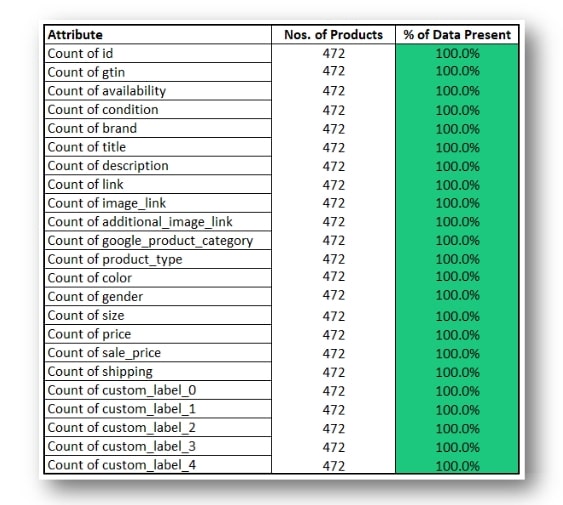
This has to be done for every distinct group of products in your catalogue and represents a significant amount of work, for even a single channel. Just imagine how much work is required to publish your product feed on the hundreds of additional channels that are also available to you? That is where a product feed platform comes in. This is because...
Not All Product Feeds Are Like Google Shopping Feeds
In shopping and search, the elephant in the room is always going to be Google. You shouldn’t even think about optimising for other shopping search sites until you’ve optimised for Google. To quickly recap: for Google Shopping you need to fully populate your feed, include all the mandatory attributes, normalise them for natural language, combine them to create more descriptive product titles and types, and experiment your way to success.
On a positive note, Google is so dominant, not only in search but in digital marketing generally, that most other channels will accept a feed that is set up and optimised for Google Shopping. Be warned, though, that having a feed accepted is NOT the same thing as having an optimised feed.
As Mark Batson, Delivery Director at Intelligent Reach, puts it:
“A Google Shopping Ad is a response to a very specific information request“.
The user searches for some information, often about a specific product, and Google Shopping responds with an advert containing exactly that information.
“But an advert for the same product on a social media platform is more of an interruption. It is not a response to a question and it has to capture the user’s attention while they are doing something else.”
To give a tangible example, when optimising for Google a product feed management company is likely to focus on manipulating the product titles and types in your feed to match specific user searches. It will do this, predominantly, by adding feed attributes such as size, colour and material to your product titles. For example: Maxi Dress becomes >Yellow Maxi Dress, cotton, size 16.
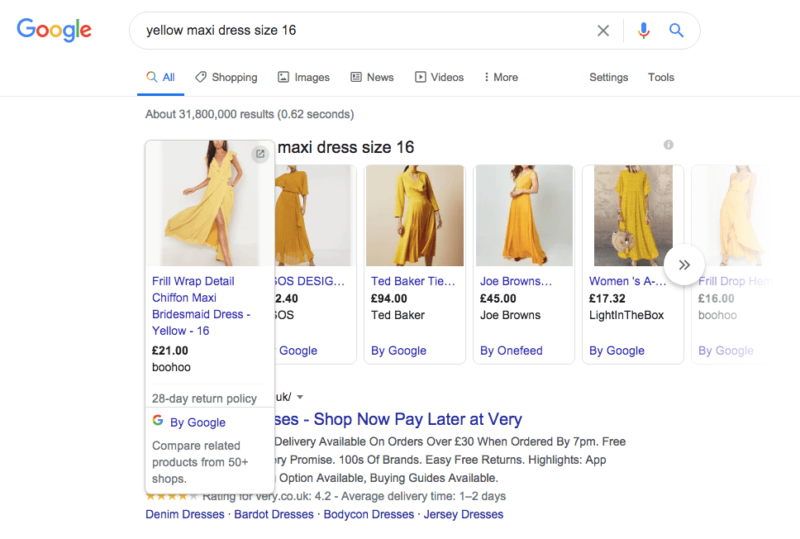
size
But what if you show the same advert to a user on social media, and they are a size 6?
Why Facebook Product Ads Are Different From Google Shopping
In social media, the dominant player is obviously Facebook, and on Facebook your dynamic product ad is typically going to be a retargeting or a lookalike audience advert. Both types of adverts are based on the idea of tracking users as they view products on a retailer’s site and then showing them the same or similar or complementary products when they visit Facebook. But when adverts actually appear on Facebook they are NOT immediately preceded by a user search. And some attributes of the user, especially size, are not necessarily known. So your product title should focus more on ranges of attributes rather than being overly specific, e.g. Maxi Dress, cotton, sizes 4-22.
Another Facebook consideration is that ads targeted at lookalike audiences tend to group products around the audiences you (and Facebook) have created. So for this activity, you may want to split your feed into different versions, one for each group of products, perhaps optimised around best sellers. Tactics may vary. The important point is that your Facebook ads demand different considerations and, therefore, a different way of managing your product data feeds.
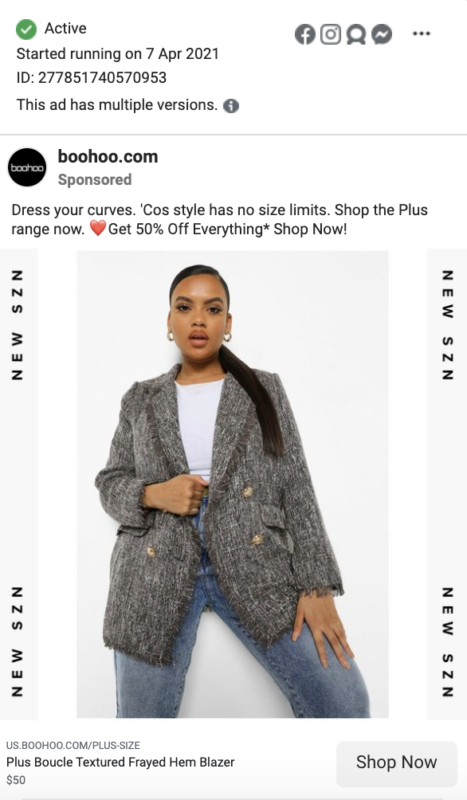
It helps to have a product feed management software company that understands these considerations and offers tools that support the creation of multiple feeds very quickly, even at a granularity of one feed per ad type, per product group, per channel.
Welcome To The Jungle (Of Product Marketplaces)
Just as Google and Facebook are the dominant players in shopping search and social media, Amazon is the big beast of product marketplaces.
Google is a search engine, Facebook a social network and Amazon a glorified shop, albeit the biggest and most well-stocked shop we have ever seen, Amazon is significantly more complicated to work with than either Google or Facebook. The main reason is that adverts on Amazon link to purchase pages on Amazon, rather than the retailer’s own store. As well as populating and optimising a product feed, you are also populating an Amazon store.
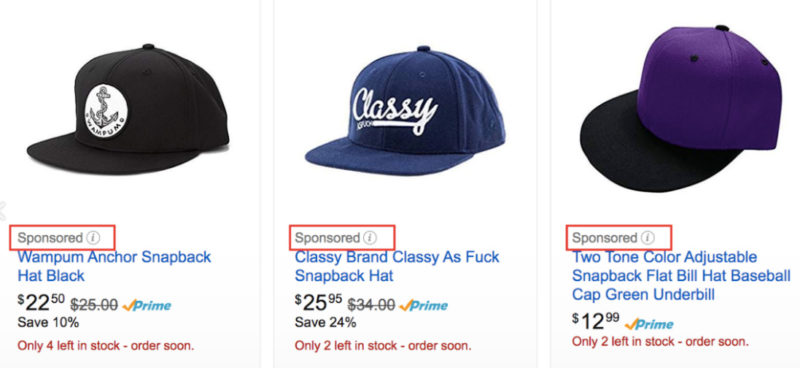
In addition to paying serving fees for your Amazon ads, you are paying seller fees to Amazon for moving your products. But according to Forbes in 2020, 59% of brands selling on Amazon said that the platform generated their highest return on media spend, followed by Google (22%) and paid social (17%). So, while cumbersome, the platform still justifies the investment in time and effort, at least for a majority of brands.
The key issue to consider with an Amazon product feed is that they tend to have fewer fields, albeit with denser content. The data for each product in the feed data is going to look like the content of a product page, so the field containing the product descriptions, for example, is likely to be very full, and the field highlighting key features is going to be a bullet point list a bit like this:
- Dimensions
- Age appropriateness
- Country of origin
- Warranty information
Clearly, your optimised Amazon feed is not going to look exactly like your optimised Google feed so Amazon (and other marketplaces such as eBay) need to be considered in their own right.
Dynamic Advertising Also Provides A Strong Return on Ad Spend (ROAS)
The final sector to consider is that of general product advertising. By far the most effective aspect of this is retargeting (or remarketing) and by far the biggest player in retargeting is Criteo.
Like Facebook’s retargeting offering, Criteo adverts typically mirror the user’s browsing history, that is they track the products the user viewed when they visited the retailer’s site and play them back in adverts that appear on other websites. They typically do this by recording the products viewed via a unique identifier, such as an SKU or EAN. Then they playback the same products in an advert when the user reappears on another site by looking up the identifiers in the product feed, rather than matching on a search term.
For this reason, an optimisation for a Criteo product feed is not going to focus on enhancing product names and titles with attributes (this won’t improve matching). It will perhaps be more about promoting deals and discounts, or perhaps just about the visuals.
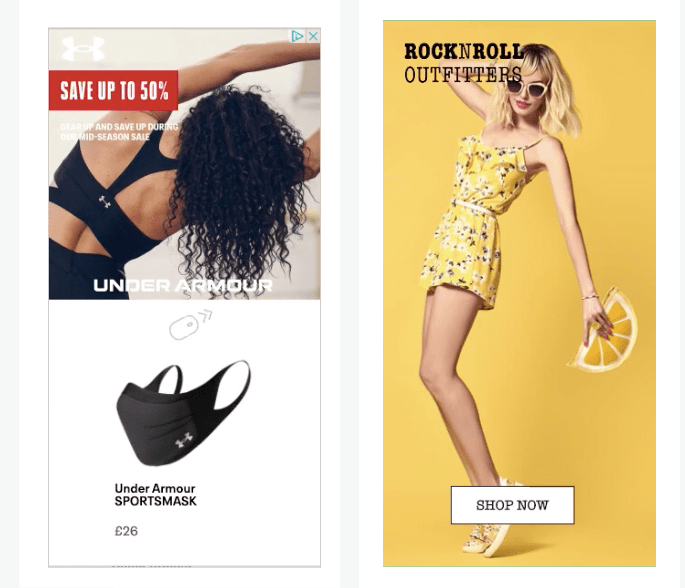
Criteo has also moved into the area of connected TV, which allows it to deliver product adverts based on location and demographic profiles (a bit like Google Local Product Ads).
The key difference between Criteo retargeting adverts and Facebook’s is that Criteo ads run on the Internet at large rather than on the supplier’s own walled-garden inventory.
Retargeting works very well and offers an excellent Return On Ad Spend (ROAS). So it would usually be considered an important part of any retailer’s media mix and, as such, an obvious destination for their product data feed.
Other Product Data Channels Are Available
Other channels that make use of product data feeds are affiliate networks (there are dozens of networks and tens of thousands of affiliate sites vying for your feed), email marketing and, increasingly, onsite applications which use data feeds to enrich the user journey on the retailer’s own website.
In order to maximise the opportunity of working with any or all of these channels, you need a feed provider that has experience in creating data feeds for all of them and tools that allow you to optimise the feeds accordingly.
MULTICHANNEL CHECKLIST:
- Does the vendor cater for all of the key channels (e.g. shopping, markets, affiliates, retargeting, onsite, local etc.)?
- How long does it take to get started and get up to speed?
- Can the product feed management software handle multiple feed variants?
- Can it handle the volume of products you plan to carry for the foreseeable future?
- Does it support your existing channels and any additional channels you might want to add in future?
- Can each feed be localised to different territories?
- Can each data field be manipulated extensively (even to the extent of completely rewriting some of the fields if required)?
- Does the software stay up to date with best practice for each channel?
Actionable Insights, Insightful Actions - How Your Product Feed Management Software Can Help
Segmenting and labelling products for campaigns can be intense and challenging, especially when the process is a manual one. Which products are performing well, on what channels? Are some products performing differently online than they are in store?
Which ones, and why? Is it possible to run an experiment that will give us actionable insights for every product or product group, across potentially hundreds of channels?
This is not a process that can be managed manually, even with a great feed-management partner. So product feed management software is going to be key.
In order to create an appropriate feed for every product group in your preferred channels, your feed management partner must have a platform that understands every channel and is set up to support them.
And, in order to test different approaches to different product groups across multiple channels, you need to be able to run a large number of experiments. This means your product feed management software has to be capable of replicating and manipulating your master data feed into hundreds, if not thousands, of different instances.
Each instance has the potential to become a successful new master feed or a failed experiment. It's best to have software that allows you to quickly make this determination so you can promote the former, delete the latter and move on to the next round of experiments.
But how can you monitor the performance of complex experiments at this sort of scale?
Integrate Your Advertising Platforms And Your Feed Management System
Your feed provider MUST be able to integrate THEIR software with your advertising channels so that your experiments are connected to real-world performance data. Once your experiments sit alongside your real-world clicks, sales and ROAS, they can be checked against your product data quickly and accurately and approved or declined.
To give a specific example from the Intelligent Reach platform, when running experiments on Google it is critical to have Google Ads performance data available in the feed management platform to determine how products are performing and streamline your processes.
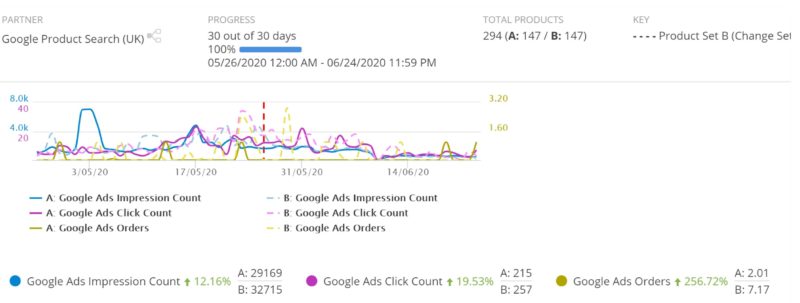
Because we can see the performance data in the same dashboard as the feed parameters, we can see that this experiment – adding the size to the product name on Google Shopping – has created an increase in the number of orders of 256,72% and an increase in total order value of 166%.
At this point, a fully integrated feed management system will allow you to quickly promote this experiment to a full update.
PERFORMANCE CHECKLIST
- Are your experiments effective, accurate and possible to perform?
- Is it solely Before and After tests, or can you A/B test (and multi-variant test) different variants of your feed to accurately gauge performance?
- Can you optimise product titles, product types and product images as well?
- Does the solution work as quickly and as well with very large data sets, while continuing to provide analytics down to individual SKUs?
- Does the software dramatically improve the efficiency of your processes, as well as the performance of your feeds?
- Does the software radically automate currently manual processes?
- Can you roll out right away your successful experiments?
- How easy is it to use the software, and to train others in your organisation to use it?
- Is the software regularly updated?
THE IMPORTANCE OF INTEGRATION WITH E-COMMERCE PLATFORMS
Google Shopping KPIs would typically take the form of increased impressions, clicks or orders as measured on the Google Shopping channel. These would be imported and converted to AOVs and ROAS automatically in your feed platform.
Alternatively, an experiment for a product feed destined for a retargeting advert would need to be integrated with performance data coming from the retailer’s own shopping basket and check out system. For many retailers, this will require integration between their product feed management software and their e-commerce platform (e.g. Magento, Shopify etc.).
According to Intelligent Reach’s Director of Customer Solutions, Mark Baston, systems integration is one of the most critical aspects of feed management.
“Deeper source data is key - our direct integration with Magento, for example, gives us deep data - without it we couldn't provide the insights that drive improvements for Magento customers.”
But integration shouldn't be limited to just a few key vendors, he says:
“We integrate with all the leading platforms and PIMs, but we will also carry out custom integrations for our clients if required, even for bespoke or legacy systems. Without the performance data they can’t properly manage their product data feeds.”
Another benefit of deeper integration between e-commerce and product feed management software is access to real-time stock data for every product. This might seem an ambitious element to add to your product data feed, but it will unwrap some powerful, perhaps even essential, product marketing features.
Number one of these is the ability to NOT advertise products that are out of stock! There are few things more frustrating for your customers than following a product from an advert to check out, only to find that it is out of stock. To add insult to injury, you are paying steep advertising fees to upset your customers in this way! Google thinks this is such an important issue that it has made stock level a mandatory field in feeds for local ads.
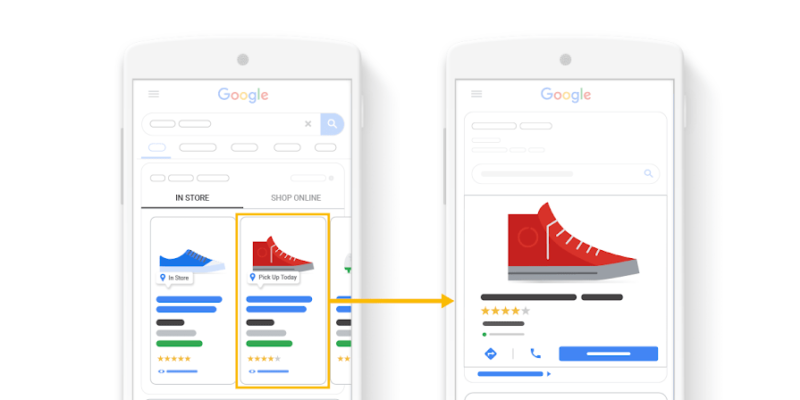
Other benefits include the ability to add ‘stock’ information to your adverts, to build urgency (“selling fast”) or as a customer service (“only three remaining”).
INTEGRATIONS CHECKLIST
- Can the software integrate with all of your key performance data?
- Can/will the feed management company integrate with your own inventory management system?
- Are orders and inventory updated in real-time from third-party websites to your e-commerce platform?
The Essential Shopping List When Searching For The Best Product Feed Management Software
If you are in the market for a (new) product data management provider there are a few items that should be on your final shopping list:
- Your new product data management partner should understand and support the key markets of shopping, social, marketplaces, dynamic advertising and onsite engagement.
- At a minimum, they should provide you with a specialist template for each of those markets and tools that allow you to manipulate them to create feed variants that improve performance in every channel.
- Your new partner should offer software that supports product-level experiments and they should be enthusiastic about integrating with your inventory management system and your analytics tools. With performance data from your analytics partners, your experiments will be accurate and efficient and can quickly become part of your daily regime.
- With real-time inventory data, your feeds will be fully up to date. They can be utilised in local offline campaigns and products that are out of stock can be effectively removed from shopping campaigns and adverts.
- Your feed partner should have a reputation for service. With great service, powerful tools and deep integrations your new partner will onboard you quickly and efficiently.
- Most of all, your new partner should be driven by data. Your feed management platform needs to have access to every morsel of data that is relevant to your business.
- Understanding how to improve your performance through your product data allows you to monitor your underperforming products, optimise them at the group or product level, experiment with variants until the right performance is achieved and iterate until every product in your feed is performing at the optimal level in every channel. This is essential to your own marketing activity. It should be a byword for your product data feed management partner.
Future-Proofing Your Product Feed Management Partner Checklist:
DATA
- Does your new partner integrate with all your key data sources?
- Does your new partner seamlessly integrate with your e-commerce platform for inventory and order management?
- Does your new platform maintain the integrity of your data?
- Does your new partner scale up in high-peak retail periods to support an increased demand?
- Does your platform allow you to understand your data, spot errors and fix them at scale?
EXPERIMENTATION
- Does your new provider support thorough tests on your key digital channels? What tests?
- Does your new provider integrate with your main ads channels to combine performance data and product data?
- Is the process of testing lean and does it help to streamline your processes?
- Does your new provider allow you to run tests at product-level?
SUPPORT
- Does the vendor onboard you? In weeks rather than months?
- Do they provide different levels of support, according to your needs?
- Are there up-to-date training materials?
- Does the vendor provide rapid customer support?
- What is their response time like?
- Are they proactive in suggesting what's the next move?
EXPERTISE
- How long has the vendor been working in this field?
- Who are their key customers and what do they say about them?
- Are they on top of feed spec updates and are they able to help you understand its impact too?
VALUE
- Does the supplier offer the type of service that suits you?
- Does their platform empower you to do more than you have ever expected?
INNOVATION
- Do the platform and its roadmap include machine learning for the improvement of your feed management processes over time?
- Does it leverage technology that makes your day-to-day data tasks easier, e.g. automation, machine-learning, etc?
- Do you think of the vendor as a long-term strategic partner?
- Does your new partner enhance performance through relentless improvements in the use of data?
CUSTOMER PROOFED
- Are reviews from their customers positive? About the platform and the service?
- Have they won any industry awards?
- Have they got relevant success stories?
INTELLIGENT REACH: BEYOND PRODUCT FEED OPTIMISATION
At Intelligent Reach, we've built the complete and intuitive Product Feed Platform for leading brands and retailers to drastically enhance their digital revenue through product data.
Having your feed in shape is the baseline: go the extra mile and start a journey of continuous optimisation and testing.
Want to download the entire checklist? We've summed up all the considerations you need to keep with you.
GET THE FULL CHECKLIST
It'll come in handy for when you're looking for a feed provider that ticks all the right boxes.
DOWNLOAD NOW




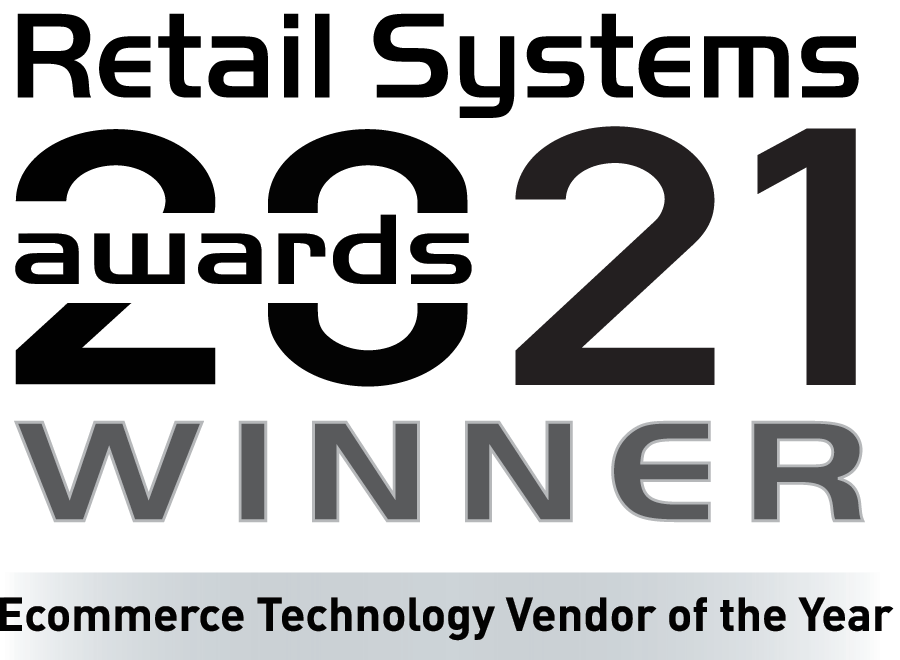







 River Island
River Island